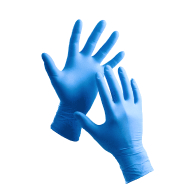Icoguanti PALMPRO 736 Natural Rubber Latex Disposable Glove
Icoguanti
visit storeProduct description
Powder-free latex, micro-rough, inside with Aloe Vera gel, weight 6.5 g, thickness 0.14 mm - DM I
Total mass of the glove package, useful for shipping calculations, storage planning, and comparing product quantities across different brands.
The visual appearance of the glove material, ranging from basic colors to specialized options for different professional and aesthetic preferences.
The texture of the glove exterior, affecting grip strength and handling capability for different tasks and working conditions.
Indicates whether gloves contain powder on the interior surface to aid donning, affecting ease of use and contamination control requirements.
Your go-to gloves for diverse tasks, offering reliable protection and convenience across many applications.
Complete finger coverage ensures full protection and hygiene for your hands, maintaining dexterity for all tasks.
Describes the surface texture of the fingertip area, affecting grip strength and tactile sensitivity during use.
- Chemical Resistance
- Medical Protection
- Antimicrobial Protection
Request a free sample
Test first and buy later. Visit any product page to request your free sample.
Standards and labels
EN ISO 374-1:2016 is a standard that defines the performance requirements for gloves that protect against chemicals and microorganisms. The standard specifies the design, materials, and testing requirements for gloves to protect against chemicals and microorganisms. Possible test results include measurements of the gloves' permeation resistance, degradation, and penetration. It also includes the safety and functionality requirements for gloves.
Test results
Specified Requirements Type BEN 374-5:2016 is a European standard for gloves that protect against microorganisms, specifically gloves that are used for medical and dental procedures. It sets rules for how the gloves should protect against microorganisms and how to test if they meet the standards. Gloves that pass the tests can have a label that says they meet the standard. The test results can be pass or fail for each test that checks the gloves resistance to microorganisms.
Test results
Micro-organisms Bacteria & FungiEN 374-5:2016 specifies the requirements and test methods for protective gloves intended to protect against bacteria and fungi. The designation 'Bacteria & Fungi' indicates that the gloves have been tested and verified to provide effective barrier protection against microbial agents. The testing involves evaluating the glove's material and seams for their impermeability to microorganisms under conditions that simulate real-world use, ensuring no penetration occurs through the glove material or at the seams. Gloves certified under this standard are crucial for use in environments such as healthcare, laboratory settings, and any applications where preventing the transmission of infectious agents is essential. They help ensure the safety and hygiene of workers by providing reliable protection against the risks of bacterial and fungal contamination.
EN 455-2:2015 is a European standard for disposable medical gloves. It sets out the definition, performance requirements and test methods for this type of gloves. The standard includes requirements for physical properties, dimensions, packaging, freedom from holes, freedom from powder, freedom from protein, freedom from endotoxins, and freedom from pyrogens. Test results can include measurements of the gloves' physical properties, dimensions, packaging, freedom from holes, freedom from powder, freedom from protein, freedom from endotoxins, and freedom from pyrogens. This version of the standard includes some changes and updates from the 2009 version.
Test results
Physical Properties TestedThe EN 455-2:2015 standard pertains to the physical properties of medical gloves, primarily focusing on ensuring they meet required levels of durability and performance under typical usage conditions. The designation that the physical properties were Tested under this standard implies that the gloves have undergone specific testing protocols to measure their tensile strength and elasticity and have been found compliant with predefined standards. The test method for physical properties under EN 455-2:2015 involves simulating conditions to mimic normal use and stresses that gloves would experience, such as stretching, which reveals both the elasticity and tensile strength of the material. Gloves undergoing these tests are stretched until they can stretch no further without breaking, and these results indicate whether the gloves are suitable for practical use in medical environments, offering users confidence in the durability and integrity of the gloves under operational conditions.
EN 455-1:2020 is a European standard for disposable medical gloves. It sets out the definition, performance requirements and test methods for this type of gloves. The standard includes requirements for freedom from holes, tensile strength, elongation, packaging, freedom from powder, freedom from protein, freedom from endotoxins, and freedom from pyrogens. Test results can include measurements of the gloves' freedom from holes, tensile strength, elongation, packaging, freedom from powder, freedom from protein, freedom from endotoxins and freedom from pyrogens. This version of the standard includes some changes and updates from the 2000 version.
Test results
Tightness AQL #,##EN 455-1:2020 sets the standards for medical gloves for single use, focusing on freedom from holes and ensuring glove integrity. The 'Tightness' test result, indicated by an Acceptable Quality Level (AQL) value, measures the quality level acceptable for the pinhole rate in glove batches. A lower AQL value, such as 1.5, typically used in medical settings, signifies a higher level of quality control where fewer gloves with defects are allowed. The testing for this standard involves randomly selecting gloves from a batch and filling them with water to check for leaks. Gloves that pass this test at a certain AQL value are deemed safe for use in medical and surgical procedures, where maintaining a sterile environment is crucial to prevent contamination and infection. This certification ensures that users can rely on the protective barrier of the gloves against pathogens and other contaminants.
EN 420:2003+A1:2009 is a European standard that sets out the general requirements for hand protection, including comfort, fit, and dexterity. Performance requirements include resistance to abrasion, cut, tear, puncture, and impact. Test results should show the gloves meet these requirements.
CE Marking is a label that shows a product meets certain safety and environmental standards set by the European Union. To get the CE Marking, a company must test and certify their product meets these standards. CE Marking is required for many products sold in the EU, including electronics, machinery, toys and medical devices. It helps ensure that products are safe for consumers and the environment, and allows for easy trade within the EU.
Icoguanti delivery terms
Free delivery for all Icoguanti products
73,19 €
Price per 10 packages (1 000 pcs)
7,32 € / 100 pcs
Free delivery
A carton contains 10 packages (1 000 pieces)
Need larger quantities?
Other products you may like
Recently viewed
Need help?
Get help from our experts
Other products you may like
Similar products you may like
Autonomous sourcing platform
The most efficient way to source and order supplies for your operations
Sourcing
Ordering
List products you’re looking for and we’ll find the best products and prices for you – all for free.
Need help?
Get help from our experts



